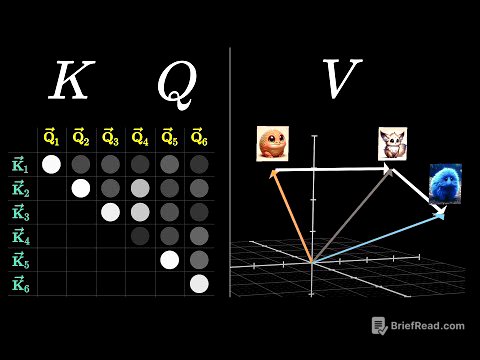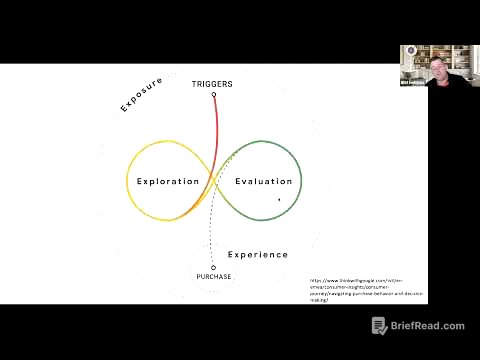Alright, here's a summary of the video on how to examine a thyroid swelling, presented in a clear and detailed manner.
TLDR;
This video provides a comprehensive guide on how to conduct a clinical examination of thyroid swelling. It covers inspection, palpation, percussion, and auscultation techniques, along with specific signs to look for related to thyrotoxicosis, myxedema, retrosternal extension, and metastasis. Key points include:
- Inspection involves observing the size, shape, location, and surface of the swelling, as well as any skin changes.
- Palpation includes assessing the consistency, borders, and mobility of the swelling, as well as examining for tracheal deviation and lymph nodes.
- Specific signs of thyrotoxicosis, such as eye signs (lid retraction, exophthalmos), tremors, and tachycardia, are detailed.
- Signs of myxedema, retrosternal extension, and potential metastasis are also discussed.
Introduction [0:00]
The video starts by introducing the process of examining a thyroid swelling, emphasizing the importance of a systematic approach. The thyroid gland is located in the front of the neck, with two lobes connected by an isthmus. The examination includes inspection, palpation, percussion, and auscultation to assess the swelling.
Inspection [0:48]
During inspection, the patient should sit straight with their neck slightly extended. Inspect the thyroid from different angles. Ask the patient to swallow to make the thyroid more prominent. If the patient has a short neck, use the Pemberton's maneuver by asking the patient to raise their arms to see if it causes facial flushing or congestion. Note the size, shape, and location of the swelling, whether it's on one side, midline, or extending from both sides. Measure the swelling in centimeters. Observe if the lower border extends behind the sternum. Ask the patient to make small swallowing movements to inspect the surface of the swelling. Note if the surface is smooth (simple goiter, single nodule) or nodular/irregular (multinodular goiter). Inspect the skin over the swelling for redness, edema (suggestive of inflammation), scars from previous surgeries, sinuses, or dilated veins. Watch the swelling for a few seconds to check for pulsations. Ask the patient to swallow and look for upward movement of the swelling, which is characteristic of thyroid swellings due to their attachment to the trachea. Also, observe for the movement of other swellings and note any high blood pressure or expansive scars.
Inspection of Thyroglossal Cyst [4:18]
If the swelling is a nodule close to the midline, test for its upward movement with tongue protrusion. Ask the patient to extend their neck and open their mouth wide. With the mouth open, tongue protrusion causes the thyroglossal cyst to move upwards because it is connected to the foramen cecum of the tongue. This movement helps differentiate it from other neck swellings.
Recap of Inspection [5:09]
To summarise inspection, note the size and location of the swelling, its borders, surface (smooth or nodular), skin changes (redness, scars), and movement on swallowing. Also, check for thyroglossal cysts by observing movement on tongue protrusion.
Palpation [5:56]
After inspection, proceed to palpation. Keep the patient in the same position, sitting with the neck extended. Palpate the swelling gently with the back of your hand to assess temperature and tenderness. Stand behind the patient and place your hands around their neck with thumbs anteriorly. Use your fingertips to feel the front of the neck. This is the standard method for thyroid gland palpation. The pressure of the palpation can be adjusted by using the thumbs. Ask the patient to make a swallowing movement while palpating to feel the gland move up and down, which helps in better appreciation of the lower border and any nodules present. Palpate each lobe individually by tilting the head to the side being examined to relax the overlying sternocleidomastoid muscle. Note the consistency, surface, and borders carefully. Palpate the trachea in the suprasternal notch to feel for any deviation.
Alternative Palpation Techniques [7:37]
Stand in front of the patient and palpate using Crile's method for deep or retrosternal goiters. Palpate the left lobe by pushing the thyroid gland to the left with your left hand and palpating with your right hand. Repeat the procedure for the right side. With the patient in the same position, use Lahey's method, where you stand to the side of the patient and ask them to swallow during palpation to feel the gland move up and down, which is useful for small goiters.
Assessing Thyroid Swelling Characteristics During Palpation [8:25]
Determine whether the entire thyroid is enlarged (goiter), if only one lobe is affected, or if it's a single nodule. If the entire gland or lobe is palpable, note whether the surface is smooth or nodular. Assess the consistency: is it uniform or variable, soft, firm, or hard? Colloid goiters are typically soft, multinodular goiters are firm, and carcinomas/Riedel's thyroiditis are hard. Carefully palpate the lower border during deglutition to determine the presence of retrosternal extension. Check for tracheal tug.
Palpation of Nodules [9:21]
If a single nodule is present, note its position within the thyroid lobe, its size, and consistency. Remember that cystic thyroid nodules are often firm, while solid swellings may be malignant. Adenomas, being highly cellular, may feel soft. When palpating a nodule, try to palpate the rest of the thyroid gland. Normally, the thyroid gland is not palpable; only its isthmus may be felt over the second, third, and fourth tracheal rings. If a single nodule is felt and the rest of the thyroid gland is impalpable, it is considered a uninodular goiter. If the rest of the gland is palpable, it is considered a multinodular goiter with a single dominant nodule.
Additional Palpation Techniques and Signs [10:39]
Gently palpate for the upper pole of the thyroid. A palpable thrill over the thyroid is diagnostic of primary thyrotoxic goiter. Pinch the swelling to look for skin tethering. Check for vertical and horizontal skin creases, which may indicate thyroiditis.
Palpation for Tracheal Deviation and Compression [11:13]
Palpate for tracheal deviation and compression. First, note the position of the trachea. Palpate the trachea downwards in the suprasternal notch. If there is unilateral deviation, the trachea can be felt more easily on one side. In cases of significant displacement, the opposite side can be appreciated. Note the position of the cricoid cartilage and tracheal rings.
Crocker's Test for Tracheal Narrowing [11:52]
Perform the Crocker's test to check for tracheal narrowing. Ask the patient to extend their neck and take a deep breath with their mouth open. Compress the swelling from both sides. The appearance of stridor on slight compression indicates narrowing of the trachea and is a positive test. This is typically seen in long-standing multinodular goiters where the trachea is compressed from both sides and becomes anteroposteriorly flattened. Stridor on compression immediately produces a harsh sound and may also be seen in thyroid cancers infiltrating the trachea.
Palpation of Carotid Artery [12:53]
Palpate the carotid artery pulsations against the transverse process of the sixth cervical vertebra, between the posterior border of the hyoid and the sternocleidomastoid. Normally, the carotid pulsations are easily felt. Compare with the left side. If a retrosternal goiter is present, the pulsations will still be felt despite the backward displacement of the artery. However, in cases of thyroid cancer, the carotid pulsations may be difficult or impossible to elicit due to infiltration. This is known as a positive Berry sign, indicating the absence of carotid pulsation in a malignant goiter.
Recap of Palpation [13:48]
To summarise palpation, use standard, Lahey's, and Crile's methods. Note the exact size and shape of the swelling, identify its borders, palpate the trachea in the suprasternal notch for deviation or retrosternal extension, assess the surface and consistency carefully, and note any thrill. Palpate for the upper pole and retrosternal extension. Palpate the trachea and carotid arteries, looking for deviation from the midline.
Percussion and Auscultation [14:55]
Percuss directly over the manubrium sterni or use heavy percussion strokes. Normally, a resonant note is heard due to the trachea. A dull note suggests retrosternal extension. Auscultate over the swelling. A bruit suggests increased vascularity, as seen in Graves' disease or toxic nodular goiter.
Signs of Thyrotoxicosis [15:54]
The video then transitions to discussing the signs of thyrotoxicosis, myxedema, retrosternal extension, and metastasis.
Eye Signs of Thyrotoxicosis [16:06]
First, look for eye signs. Ask the patient to sit upright and look straight ahead. Observe for lid retraction, where the upper eyelid is elevated above the normal level. Dalrymple's sign is the widening of the palpebral fissure due to lid retraction. Look for early lid retraction, which is more prominent in the lateral part of the upper lid. Also, note infrequent blinking.
Lagophthalmos and Von Graefe's Sign [17:38]
Test for lagophthalmos (inability to close the eyelids completely) and Von Graefe's sign (lid lag). With your left hand, fix the patient's head to prevent flexion or extension. Hold your right index finger in front of the patient's eyes at a distance of 1 meter and ask them to follow it as you move it downwards. In Von Graefe's sign, as the patient looks downwards, the upper eyelid lags behind, exposing the sclera above the iris.
Exophthalmos and Kocher's Sign [18:17]
With the progression of thyrotoxicosis, exophthalmos (protrusion of the eyeballs) may develop. Ask the patient to look horizontally forward and note if a white rim of sclera is visible between the inferior limbus and the lower eyelid. This is due to the forward displacement of the eyeball. To quantify the degree of exophthalmos, examine the patient using a Hertel exophthalmometer.
Joffroy's Sign and Convergence Test [19:21]
Ask the patient to look upwards with their head flexed downwards. Look for transverse wrinkles over the forehead, which are normally seen in this position. The absence of these wrinkles is Joffroy's sign. If exophthalmos is limited to one eye, ask the patient to look downwards. In true exophthalmos, the movement is difficult or impossible, whereas in lid retraction, the movement is possible. Test convergence by holding your finger at a distance of 1 meter from the eyes and asking the patient to stare at it. Slowly bring the finger towards the patient's nose between their eyebrows. A normal person can converge their eyes. In thyrotoxicosis, convergence may be weak or incomplete.
Progression of Eye Signs and Recap [20:38]
Progressive exophthalmos can lead to swelling of the eyelids, conjunctival congestion, and edema. In later stages, corneal ulcers, diminished vision, and ophthalmoplegia (restriction of eye movements) may occur. To summarise, look for lid retraction, lid lag, exophthalmos, Joffroy's sign, and test convergence.
Other Signs of Thyrotoxicosis: Tremors and Tongue [21:21]
Beyond eye signs, look for fine tremors of the outstretched hands. Ask the patient to stretch out their arms with their fingers slightly apart. Patients with thyrotoxicosis will exhibit fine tremors. Another method to demonstrate this is to place a piece of paper on the outstretched hands; the vibrations of the paper will be more evident. Ask the patient to open their mouth wide and stick out their tongue. The tongue should not be coarse. Look for fine tremors of the tongue, which are characteristic of thyrotoxicosis.
Pulse, Skin, and Thyroid Thrill [22:36]
Feel the radial pulse. In thyrotoxicosis, the pulse is rapid and bounding. Tachycardia is common. However, the pulse rate may vary from day to day. Irregular pulse may indicate atrial fibrillation. Feel the palms of the patient's hands. In thyrotoxicosis, the palms are warm and moist. The skin may show pretibial myxedema with thickened, hyperpigmented skin and coarse hair. A palpable thyroid thrill and a bruit on auscultation are also characteristic of thyrotoxicosis.
Signs of Myxedema [24:08]
To identify signs of myxedema, look for a dull, puffy face, loss of the outer third of the eyebrows, periorbital edema, a large tongue, and dry skin. Listen for a slow, hoarse voice. Note the slow relaxation phase of reflexes, particularly the ankle jerk. The muscle contracts quickly but relaxes slowly.
Signs of Retrosternal Extension [25:10]
Inspect the chest, neck, and face for dilated veins, congestion, and plethora, which result from pressure on the internal jugular veins at the thoracic inlet. Palpate the tracheal rings in the suprasternal notch; inability to palpate them suggests retrosternal extension. Percuss over the manubrium sterni; a dull note instead of a resonant note suggests the presence of a retrosternal goiter.
Pemberton's Sign and Horner's Syndrome [25:46]
Pemberton's sign is elicited by asking the patient to raise their arms above their head. A positive sign is indicated by facial congestion and respiratory distress, suggesting thoracic inlet obstruction, most likely due to retrosternal extension of the goiter. Look for Horner's syndrome, which can occur if the retrosternal goiter or malignancy affects the cervical sympathetic chain. The features of Horner's syndrome include ptosis (drooping eyelid), miosis (constricted pupil), and anhidrosis (loss of sweating) on the affected side.
Signs of Metastasis [26:45]
Finally, look for signs of metastasis. Palpate the neck on both sides for enlarged, hard lymph nodes. Palpate the skull surface for hard nodules. Look for bony deformities or tenderness in long bones. Examine the liver for nodular enlargement and ascites. Examine the chest for signs of effusion and consolidation.
Conclusion [27:19]
This completes the clinical examination of a case of thyroid swelling.









